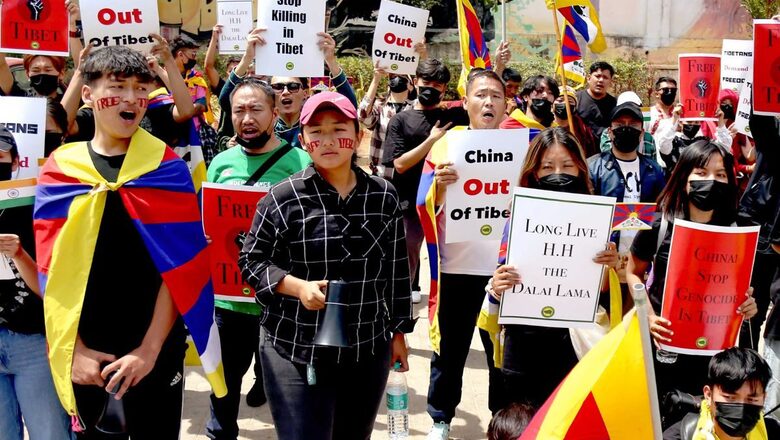
views
China has unleashed a cartographic war in the Indo-Pacific region yet again. This time, China’s internationally discredited and laughable nine-dash line has seen the addition of another line — east of Taiwan. Effectively, China now has a 10-dash-line at its disposal to illegally stake mindless territorial and maritime claims across the Indo-Pacific. Unfortunately for China, such claims neither have any legal basis nor any international standing. At best, they are viewed across the world as childish claims of a country whose economy is in deep trouble. China’s leadership — desperate as it is amid increasing economic pressures — must rally people around the flag. That is what the Chinese Communist Party hopes to do with its illegitimate maps, which are nothing more than figments of imagination.
India has lodged a strong protest with Beijing over its sovereign territories — Arunachal Pradesh and Aksai Chin — being shown as a part of China. The External Affairs Minister has himself weighed in, calling China’s claims “absurd”. He added, “China has even in the past put out maps which claimed territories which are not China’s, which belong to other countries. This is an old habit of theirs.”
China is a creature of its habits. For years now, China has released ridiculous maps — infringing upon the territories and waters of sovereign nations on paper. The problem is — these claims are not just limited to paper. By releasing such maps, China frequently attempts to normalise its outlandish territorial claims in the region. In the latest map, China has once again staked claim to the whole of the South China Sea. That has evoked strong protests from Malaysia and the Philippines as well. So, how does one deal with a country so fascinated by the idea of swallowing its neighbours’ territories?
COUNTERING THE BULLY: INDIA NEEDS TO SUPPORT TIBET
Since China is evidently not course-correcting, India must change its tactics. The time of merely and endlessly calling China out is over. As a nation of 1.4 billion people, India needs to stop outraging every time China decides to poke us in the eyes. Our current strategy is very reactionary — one that does not behove what India can really achieve. Therefore, it is time for India to respond to China in a language it understands best. What is that language? Tit for Tat.
India must start with Tibet. It had a flourishing civilisation and a deep cultural connect with India for eons. That was until China did not roll its military into Tibet and invade it in 1949. Even today, the people of Tibet yearn for freedom. As the only nation that has exchanged physical blows with China and that has time and again given the Chinese PLA a run for its money, it is time for India to take steps that will help Tibetans achieve their political aspirations. India must start with the map itself. If China can claim Arunachal Pradesh, Ladakh and Aksai Chin as its own, there is no reason why India cannot show Tibet to be a free country. The time to stand up for Tibet is now.
INDIA MUST STRENGTHEN TIES WITH TAIWAN
The threat of a military invasion looms large over the island nation of Taiwan. India needs to take a side in this inevitable war. China not only uses maps that already show Taiwan as a part of the PRC but also forces entire nations and businesses to do so. Beijing has forced several businesses, like clothing brand Gap, airline United Continental Holdings, Japan’s Seven & i Holdings Co. to apologise, change their websites, and even pay fines for depicting Taiwan as a separate nation on maps.
This is a dangerous trend, especially when seen in light of China’s reaction to India’s vehement protest. China says that the “standard map” which India strongly objected to is the “country’s normal exercise of sovereignty” and that New Delhi should ‘stay calm’. That is a load of bunkum. If maps were such a casual affair for China, it would not have been harassing countries and businesses that deviate from China’s cartographic diktats.
As such, it becomes even more important for India to set a precedent. We cannot allow China to slowly start mainstreaming such facetious maps. Instead, what is needed is for India to release its own maps, and clearly show Tibet and Taiwan as free entities. There is also China’s Xinjiang province, where the Communist regime is persecuting millions of Uyghur Muslims. India can start referring to that as East Turkestan to let Beijing know that the time for jokes is over, and that New Delhi now means business. China needs to understand that the Indian public’s tolerance towards Beijing’s provocations is wearing thin with great rapidity.
Remember, China provoked India just when hopes were beginning to rise over a possible thaw in ties between both nations, in the backdrop of constructive military talks and an informal conversation between PM Modi and Xi in South Africa. However, China is surely not in the mood for peace and normalcy, which is why it chose to release the map days before the G20 summit in Delhi. Speaking of G20, Xi Jinping is likely to skip the mega event. China is also actively trying to undermine India’s presidency. Take this: China has a problem with India’s promotion and usage of Sanskrit at the G20 summit. Beijing is being petty, and India must recognise that Xi Jinping is not interested in peace.
Therefore, India has the right to take a host of measures to protect its interests. These include strengthening the Quad partnership and working with Southeast Asian countries like Indonesia, the Philippines, Taiwan and Malaysia to counter China. All of this should come only after India releases its own map of the subcontinent. China will react harshly, but here is what India should tell Xi Jinping’s regime: “Stay calm.”
Views expressed in the above piece are personal and solely that of the author. They do not necessarily reflect News18’s views.




















Comments
0 comment